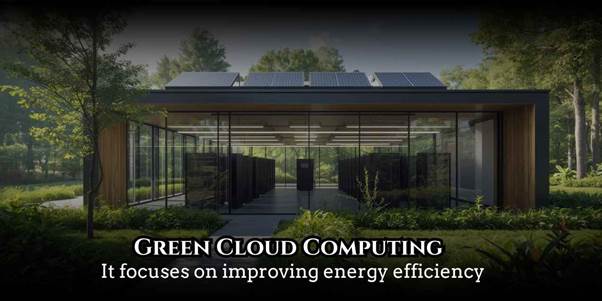In today’s rapidly evolving digital world, Green Cloud Computing is emerging as a powerful solution to balance innovation with environmental responsibility. As data centers expand and energy consumption soars, organizations are turning to eco-friendly cloud technologies that reduce carbon footprints and promote energy efficiency. This sustainable approach not only minimizes electronic waste but also drives renewable energy adoption and carbon-neutral data storage.
In this article, we’ll explore how green cloud initiatives are transforming the technology landscape highlighting their benefits, challenges, and real-world applications. By understanding the role of sustainable IT infrastructure, we can uncover how the cloud is paving the way for a cleaner, smarter, and more responsible digital future.

Understanding Green Cloud Computing
Green Cloud Computing refers to the practice of designing, operating, and managing cloud systems in ways that reduce environmental impact. It focuses on improving energy efficiency, minimizing carbon emissions, and promoting the use of renewable energy in data centers. This concept aligns technology growth with sustainability, ensuring that digital transformation does not come at the expense of the planet’s health.
Background and Evolution
The idea of sustainable cloud solutions began in the late 2000s when environmental concerns surrounding massive data centers started gaining attention. Traditional IT infrastructures consumed enormous amounts of power, much of it generated from non-renewable sources. As cloud computing expanded, so did its environmental footprint. To address this, tech giants like Google, Microsoft, and Amazon introduced initiatives for green data centers, focusing on renewable power, energy-efficient cooling, and carbon-neutral operations.
Today, Green Cloud Computing has evolved into a global movement. It combines advanced virtualization, efficient workload management, and intelligent energy use to build a more sustainable digital ecosystem.
Importance of Green Cloud Computing
The significance of adopting eco-friendly cloud practices lies in their dual benefits technological advancement and environmental preservation. Modern businesses depend on the cloud for agility, scalability, and cost savings. However, these advantages can be undermined if their systems contribute heavily to greenhouse gas emissions.
Green cloud initiatives are important because they:
- Reduce the carbon footprint of IT operations
- Conserve natural resources by promoting energy efficiency
- Encourage the use of renewable energy sources like solar and wind power
- Support corporate sustainability goals and eco-friendly brand image
- Ensure compliance with global environmental standards
By integrating sustainability into digital infrastructure, organizations can balance performance with environmental responsibility.
Related Article: Green Cloud Computing: 7 Innovative Ways Tech Giants Are Reducing Carbon Footprints
Key Benefits of Sustainable Cloud Technology
1. Energy Efficiency
Energy-efficient cloud systems use virtualization and workload optimization to reduce the total power required for computing operations. Smart data allocation ensures that idle servers are shut down automatically, lowering unnecessary energy use.
2. Cost Reduction
Sustainable cloud platforms often lead to significant operational savings. By minimizing electricity consumption and improving resource utilization, companies can lower energy bills while meeting performance demands.
3. Environmental Conservation
Green Cloud Computing promotes carbon-neutral data centers and eco-conscious IT practices. These efforts help combat climate change and preserve ecosystems for future generations.
4. Improved Corporate Image
Businesses that adopt sustainable digital strategies gain a competitive advantage. Consumers increasingly prefer brands that demonstrate environmental responsibility, and investors are drawn to companies committed to sustainable growth.
5. Technological Innovation
Green computing encourages research and development of advanced technologies such as AI-driven energy management, serverless computing, and edge data processing, which enhance both sustainability and efficiency.
Challenges in Adopting Green Cloud Practices
Despite its benefits, implementing green cloud solutions comes with challenges that must be addressed strategically.
- High Initial Costs: Upgrading infrastructure to energy-efficient systems or investing in renewable power sources can be expensive for smaller organizations.
- Limited Awareness: Many companies lack understanding of how their IT operations contribute to carbon emissions.
- Technology Complexity: Managing dynamic workloads while maintaining low energy consumption requires advanced technical expertise.
- Data Center Location: Facilities powered by non-renewable energy sources may find it difficult to achieve full sustainability.
Overcoming these challenges involves collaborative efforts between cloud providers, governments, and enterprises to invest in cleaner technologies and create incentives for sustainable innovation.
Real-World Examples of Green Cloud Success
- Google Cloud operates using 100% renewable energy and has committed to running entirely on carbon-free energy by 2030.
- Microsoft Azure uses AI and machine learning to monitor data center efficiency and has pledged to be carbon-negative by 2030.
- Amazon Web Services (AWS) invests in solar and wind farms to power its global data centers sustainably.
- IBM Cloud focuses on reducing water usage and implementing sustainable cooling technologies in its data centers.
These examples demonstrate that large-scale cloud providers are setting the benchmark for sustainability in the digital world.
The Future of Sustainable Cloud Innovation
The next decade will witness a stronger push toward eco-friendly IT infrastructure. Emerging technologies like quantum computing, AI automation, and green algorithms will further optimize resource consumption. Governments and organizations will likely enforce stricter sustainability policies, promoting transparency and accountability in data management.
The integration of renewable energy and advanced cooling systems will make data centers more efficient than ever. Additionally, businesses adopting cloud sustainability frameworks will gain recognition for their environmental leadership.

Conclusion
In summary, Green Cloud Computing is redefining how technology and sustainability coexist. By focusing on energy efficiency, renewable energy, and responsible data management, it enables businesses to grow without harming the environment. The adoption of these eco-friendly practices is not just a trend but a crucial step toward a more sustainable digital era. As organizations continue to innovate, embracing green cloud solutions will be key to reducing carbon footprints and building a cleaner future. To stay ahead, explore emerging green technologies and join the movement toward a smarter, sustainable cloud.
Pingback: Green Cloud Computing: 7 Innovative Ways Tech Giants Are Reducing Carbon Footprints - Techyways